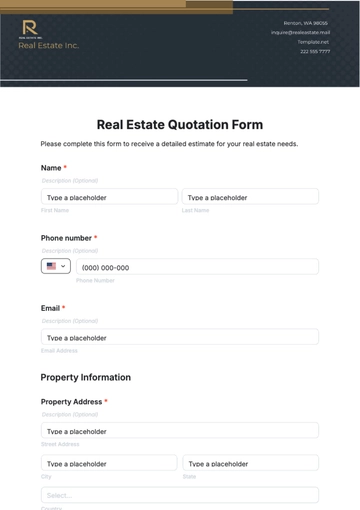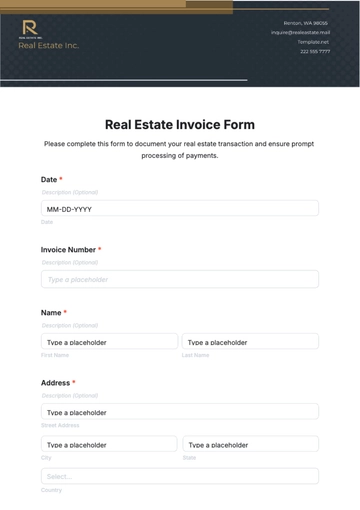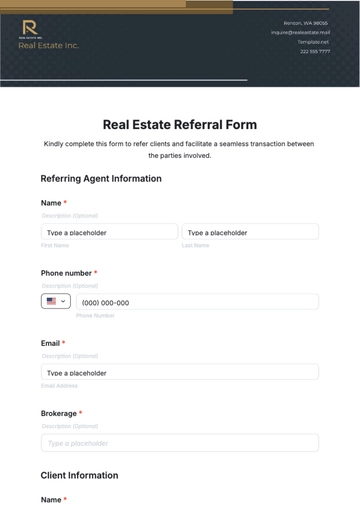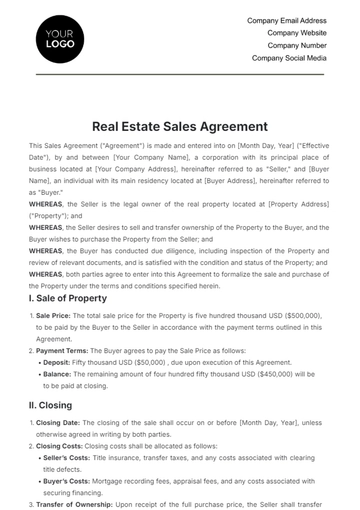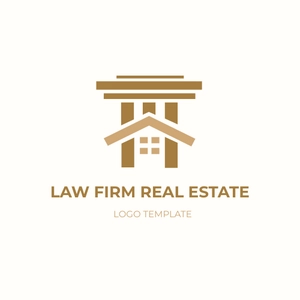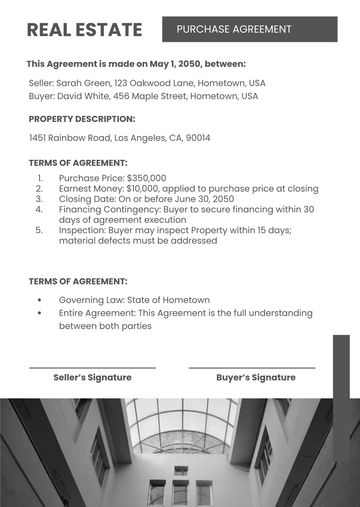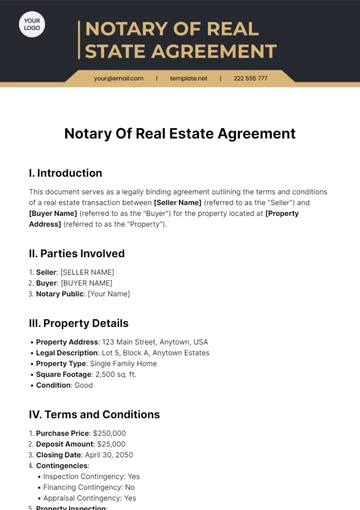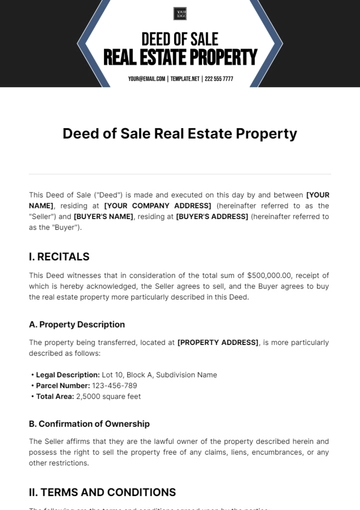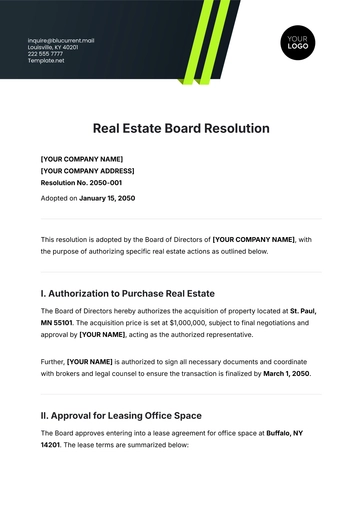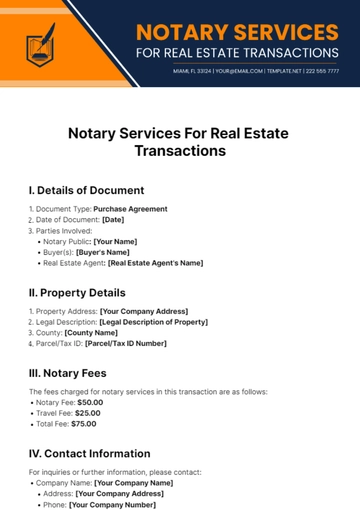Free Real Estate Implementing Sustainable Technologies Guide
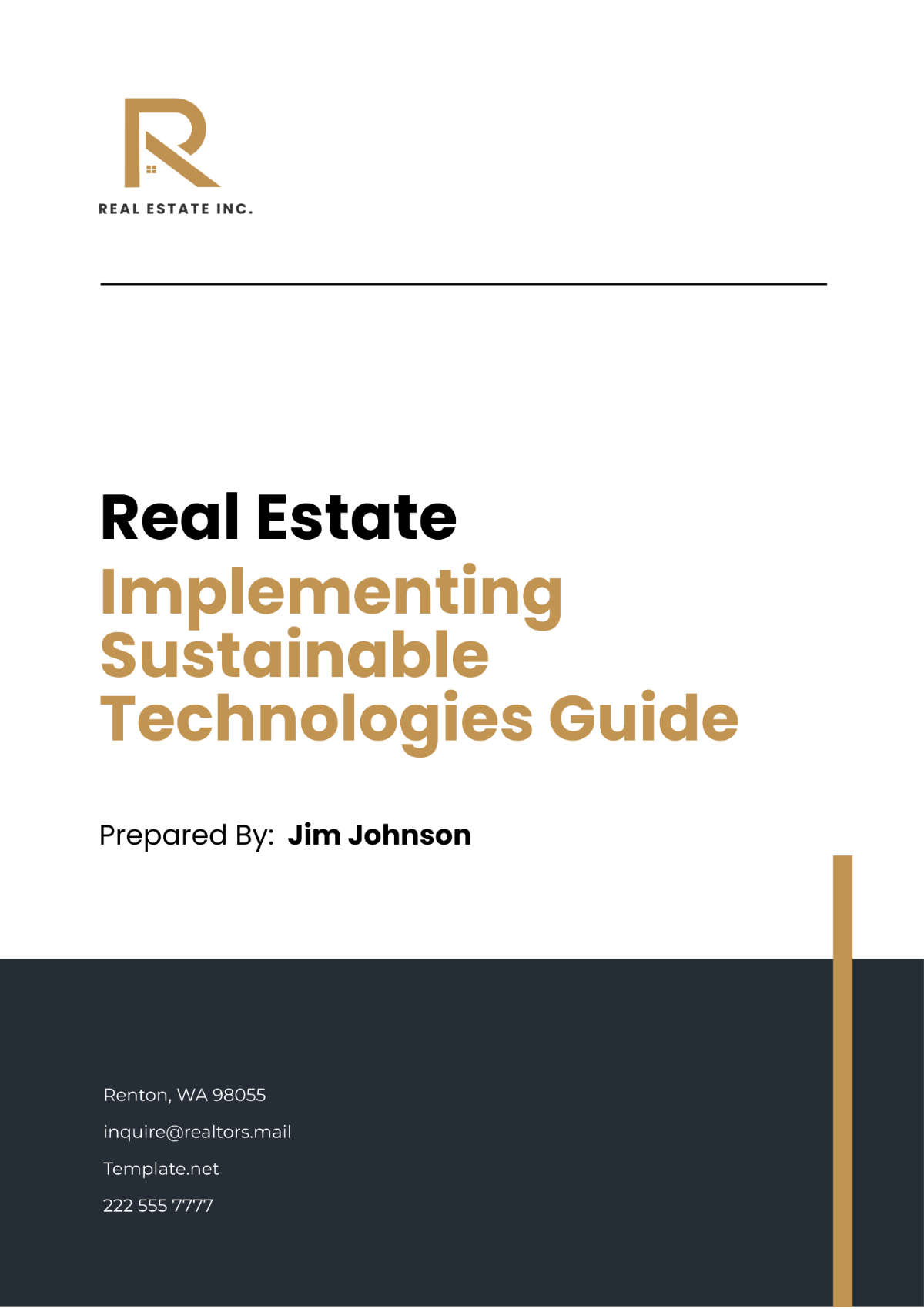
I. Introduction
In the ever-evolving landscape of the real estate industry, sustainability has emerged as a key driver for success and longevity. This guide for [Your Company Name] delves into the significance of sustainable technologies and offers a roadmap for real estate companies aiming to weave these innovations into their business fabric. The incorporation of sustainable technologies not only aligns with global environmental goals but also propels companies towards achieving economic benefits and enhancing their market standing.
II. Benefits of Sustainable Technologies
Sustainable technologies are not just add-ons but are fundamental shifts that redefine the real estate sector's approach to environmental responsibility, operational efficiency, and stakeholder satisfaction. Here's an expanded look at the benefits:
Reduce Carbon Footprint
Adopting sustainable technologies is a pivotal step towards minimizing the environmental impact of real estate operations. By significantly reducing greenhouse gas emissions, companies contribute to global efforts against climate change. This not only aids in preserving natural ecosystems but also aligns real estate practices with international environmental standards and regulations, mitigating legal and compliance risks.
Lower Energy Costs
The financial implications of integrating sustainable technologies are profound. Through energy savings, real estate entities can experience a direct reduction in operational expenses. This is particularly crucial in a market where utility costs can fluctuate dramatically. Over time, the initial investment in these technologies pays off, leading to considerable net savings that can be reinvested into further sustainability initiatives or other areas of the business.
Enhance Brand Reputation
In an era where consumers and businesses alike prioritize environmental consciousness, a commitment to sustainability can significantly enhance a company's brand reputation. This shift not only attracts tenants and investors who are eager to associate with green initiatives but also positions the company as a leader in sustainable development. Public relations benefits include positive media coverage and recognition through awards and certifications, further solidifying the company's standing in the market.
Increase Property Value
Properties equipped with sustainable technologies often see an increase in their market value. This is due to growing demand for green buildings, which are perceived as more modern, healthier to live or work in, and cheaper to operate. Additionally, such properties often qualify for various incentives, including tax rebates and grants, making them more attractive to both buyers and renters.
Improve Tenant Satisfaction
Sustainable technologies contribute significantly to the comfort and well-being of tenants. Features like improved air quality, natural lighting, and temperature control create a more pleasant and healthy environment. This leads to higher tenant satisfaction and retention rates, reducing turnover costs and vacancies. Furthermore, engaging tenants in sustainability efforts fosters a community spirit, enhancing their loyalty and satisfaction.
III. Incorporating Sustainable Technologies
When delving into the specifics of incorporating sustainable technologies, it's essential to consider not just the cost and implementation strategies but also the broader impact on the real estate ecosystem.
The table below outlines essential technologies that real estate companies can adopt, along with their benefits, costs, and implementation strategies:
Technology | Description | Benefits | Cost | Implementation |
|---|---|---|---|---|
Solar Panels | Harness solar energy | Reduce electricity costs | High initial investment | Rooftop installation |
Energy-efficient HVAC systems | Regulate temperature efficiently | Lower energy consumption | Higher upfront cost | Retrofitting existing systems |
LED Lighting | Energy-efficient lighting | Reduce electricity usage | Moderate cost | Installing in common areas |
Solar Panels
Harnessing solar energy represents a clean, inexhaustible power source that drastically cuts electricity costs. While the initial investment may be high, solar panels often qualify for government incentives, reducing the overall cost. The implementation, typically through rooftop installations, can be planned during new constructions or as part of renovations. Beyond financial savings, solar panels serve as a visible commitment to sustainability, enhancing the property's appeal to eco-conscious tenants and buyers.
Energy-efficient HVAC Systems
Upgrading to energy-efficient HVAC systems is a critical move for reducing energy consumption and improving indoor environmental quality. Although these systems come with a higher upfront cost, the long-term energy savings are significant. Retrofitting existing systems requires careful planning to minimize disruptions but can dramatically improve the efficiency of older buildings. Beyond cost savings, efficient HVAC systems contribute to a healthier indoor environment, crucial for tenant satisfaction and well-being.
LED Lighting
Transitioning to LED lighting is one of the most straightforward and cost-effective ways to reduce electricity usage. With a relatively moderate cost, the implementation can be rapidly achieved by installing LEDs in common areas, parking lots, and individual units. LED lighting not only lowers energy bills but also offers longer lifespan than traditional bulbs, reducing maintenance and replacement costs. This technology enhances the quality of light, improving safety and aesthetics, which are key factors in tenant satisfaction.
Integrating sustainable technologies is a strategic necessity for the real estate sector, offering significant environmental, economic, and social benefits. Beyond the immediate advantages, these technologies are investments in the future resilience and competitiveness of real estate assets. As the industry evolves, sustainability becomes not just a differentiator but a baseline expectation, guiding companies towards a more sustainable, profitable, and responsible business model.
IV. Best Practices for Sustainable Real Estate Development
Conduct Energy Audits
Energy audits are a foundational step for [Your Company Name] in the journey toward sustainability. By systematically evaluating energy use and identifying inefficiencies, [Your Company Name] can pinpoint actionable opportunities for reducing energy consumption and costs. This involves a thorough assessment of heating, ventilation, air conditioning (HVAC) systems, lighting, insulation, and other energy-consuming aspects of the property. An energy audit not only reveals areas for improvement but also sets a benchmark for measuring the impact of future green initiatives. Implementing the recommendations from energy audits can lead to substantial savings and is a critical component in the roadmap towards sustainability.
Invest in Green Building Certifications
Green building certifications, such as LEED (Leadership in Energy and Environmental Design) or BREEAM (Building Research Establishment Environmental Assessment Method), are more than just badges of honor. They represent a commitment to sustainability that resonates with investors, tenants, and the broader community. For [Your Company Name], pursuing these certifications means adhering to the highest standards of environmental performance, which can significantly enhance the credibility and value of your properties. Moreover, certified buildings often enjoy higher occupancy rates, rental premiums, and resale values, making this investment beneficial from both environmental and economic perspectives.
Educate Staff and Tenants
Sustainability is a collective effort, and its success hinges on the active participation of all stakeholders, including staff and tenants. [Your Company Name] should foster a culture of sustainability by providing education and resources to employees and residents about how they can contribute to energy savings and environmental protection. This could include workshops, informational materials, and incentives for adopting green practices. Empowering tenants to live sustainably can significantly amplify the impact of [Your Company Name]'s green initiatives, turning individual actions into a powerful collective force for change.
Monitor Energy Usage
Ongoing monitoring of energy usage is essential for understanding the effectiveness of implemented sustainable technologies. [Your Company Name] can use smart meters and building management systems to track energy consumption in real time, allowing for the identification of unexpected spikes or inefficiencies. This data-driven approach enables timely adjustments and fosters a culture of continuous improvement. Regular reporting on energy performance can also be a powerful tool for engaging stakeholders, demonstrating progress towards sustainability goals, and identifying areas for further improvement.
Collaborate with Specialists
The complexity of sustainable technologies and green building practices necessitates partnerships with specialists who bring expertise and experience to the table. [Your Company Name] should seek out suppliers, contractors, and consultants who are leaders in sustainable solutions. Collaborating with these specialists can ensure that the latest, most effective technologies and methods are used in your projects. This not only enhances the sustainability of your properties but also helps to build a network of like-minded companies and professionals, fostering a collaborative ecosystem geared towards sustainability.
V. Case Studies
Green Building Certification
Company A's journey to achieving LEED Platinum certification for their office building is a testament to the transformative power of green building practices. Through a comprehensive strategy that included energy-efficient design, water conservation measures, and the use of sustainable materials, Company A not only enhanced the building's environmental performance but also its market appeal. This achievement led to a remarkable 30% reduction in energy consumption, translating into significant cost savings and a stronger competitive edge in the real estate market. Furthermore, the increased tenant occupancy rates highlight the growing demand for green buildings and the potential for sustainable practices to drive business success.
Solar Panel Installation
Company B's decision to install solar panels across their residential properties represents a proactive approach to sustainability. By harnessing renewable energy, Company B was able to cut electricity costs by an impressive 40%, delivering direct financial benefits to both the company and its tenants. This initiative also significantly boosted the appeal of their properties among eco-conscious consumers, demonstrating how sustainable technologies can serve as a key differentiator in the real estate industry. The success of Company B's solar panel installation underscores the viability and attractiveness of renewable energy solutions in today's market.
VI. Conclusion
For [Your Company Name], embracing sustainable technologies is a strategic imperative that transcends the realm of trend-following. It is a commitment to the future—a vision for a real estate industry that is not only more environmentally responsible but also more economically sound and socially inclusive. This guide provides a comprehensive framework for [Your Company Name] to embark on or advance its sustainability journey, offering practical insights and inspiration from industry pioneers.
As [Your Company Name] navigates the complexities of the real estate market, the adoption of sustainable technologies and practices is a powerful means to differentiate itself, attract forward-thinking tenants and investors, and contribute to the global effort against climate change. Sustainability is the foundation upon which the future resilience and growth of the real estate industry will be built, ensuring a greener, more profitable, and equitable world for generations to come.
- 100% Customizable, free editor
- Access 1 Million+ Templates, photo’s & graphics
- Download or share as a template
- Click and replace photos, graphics, text, backgrounds
- Resize, crop, AI write & more
- Access advanced editor
Unlock the future of real estate sustainability with Template.net's Implementing Sustainable Technologies Guide. Tailored for eco-conscious professionals, this template empowers you to integrate cutting-edge technologies seamlessly. With our AI editor, customize every detail to suit your vision effortlessly. Harness innovation, reduce environmental impact, and lead the industry towards a greener tomorrow with this versatile template.

